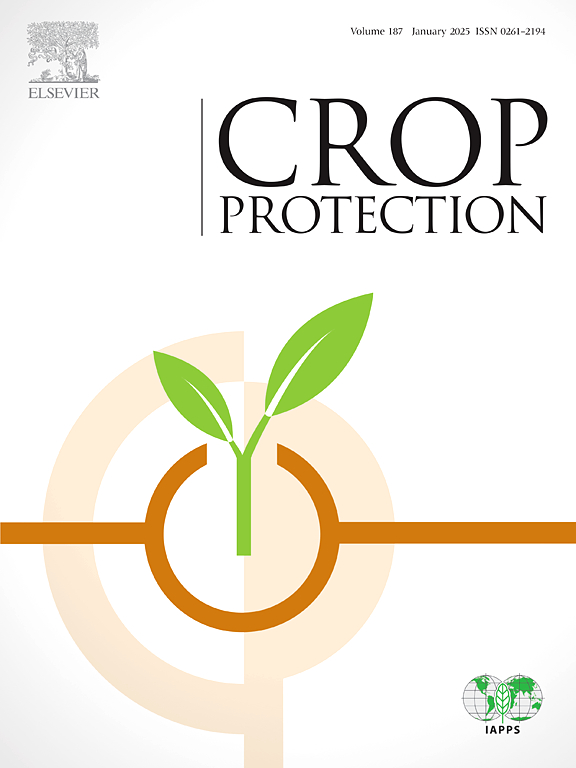Can repellent crops reduce the abundance of the common vole (Microtus arvalis) as a way to reduce crop damage?
IF 2.5
2区 农林科学
Q1 AGRONOMY
引用次数: 0
Abstract
The common vole is one of the most damaging rodents in agriculture. A number of methods are used to suppress its numbers and limit damage. One option is growing crops that are not suitable for voles; this might limit their numbers and distribution. Through long-term monitoring of common voles throughout the Czech Republic, their abundance in eleven crop types (annual, biennial and perennial crops) was evaluated through active burrow counts. Reference crops were selected from perennials and biennials and annual crops were selected as potential repellents. The perennial crops were clover with alfalfa, which serve as the primary habitat for voles. These crops are where voles are found in their highest densities, and from which they spread to the surrounding crops during periods of high abundance. The biennial winter rape was selected because it provides favourable conditions for voles to overwinter and multiply rapidly in the spring. Compared to perennial crops and winter rape, significantly lower numbers of voles were found in onions, poppy seeds and maize. Additionally, fewer voles were also found in mustard compared to perennial crops. Onion and poppy were the only crops to show a significantly lower abundance of voles in comparison to wheat. The annual crops tested are unattractive to voles and due to the cultivation practices used, they do not even have enough weeds as food. As profitable crops they can be cultivated over sufficiently large areas to potentially prevent the spread of voles to surrounding crops, especially during outbreak years.
驱避作物能否减少普通田鼠(Microtus arvalis)的数量,从而减少对农作物的损害?
普通田鼠是农业中危害最大的啮齿动物之一。有许多方法可以抑制田鼠的数量并限制其危害。其中一种方法是种植不适合田鼠生长的作物;这可能会限制田鼠的数量和分布。通过在捷克共和国全境对普通田鼠进行长期监测,对其在 11 种作物(一年生、二年生和多年生作物)中的数量进行了评估。参考作物选自多年生和二年生作物,一年生作物则被选为潜在的驱避剂。多年生作物是三叶草和紫花苜蓿,它们是田鼠的主要栖息地。田鼠在这些作物上的密度最高,在田鼠大量繁殖期间,它们会从这些作物向周围的作物扩散。之所以选择两年生冬油菜,是因为它能为田鼠提供有利的越冬条件,并在春季迅速繁殖。与多年生作物和冬油菜相比,洋葱、罂粟籽和玉米中田鼠的数量明显较少。此外,与多年生作物相比,芥菜中发现的田鼠数量也较少。与小麦相比,只有洋葱和罂粟的田鼠数量明显较少。测试的一年生作物对田鼠没有吸引力,而且由于采用的种植方法,它们甚至没有足够的杂草作为食物。作为有利可图的作物,它们的种植面积足够大,有可能防止田鼠向周围的作物扩散,尤其是在田鼠疫情爆发的年份。
本文章由计算机程序翻译,如有差异,请以英文原文为准。
求助全文
约1分钟内获得全文
求助全文
来源期刊

Crop Protection
农林科学-农艺学
CiteScore
6.10
自引率
3.60%
发文量
200
审稿时长
29 days
期刊介绍:
The Editors of Crop Protection especially welcome papers describing an interdisciplinary approach showing how different control strategies can be integrated into practical pest management programs, covering high and low input agricultural systems worldwide. Crop Protection particularly emphasizes the practical aspects of control in the field and for protected crops, and includes work which may lead in the near future to more effective control. The journal does not duplicate the many existing excellent biological science journals, which deal mainly with the more fundamental aspects of plant pathology, applied zoology and weed science. Crop Protection covers all practical aspects of pest, disease and weed control, including the following topics:
-Abiotic damage-
Agronomic control methods-
Assessment of pest and disease damage-
Molecular methods for the detection and assessment of pests and diseases-
Biological control-
Biorational pesticides-
Control of animal pests of world crops-
Control of diseases of crop plants caused by microorganisms-
Control of weeds and integrated management-
Economic considerations-
Effects of plant growth regulators-
Environmental benefits of reduced pesticide use-
Environmental effects of pesticides-
Epidemiology of pests and diseases in relation to control-
GM Crops, and genetic engineering applications-
Importance and control of postharvest crop losses-
Integrated control-
Interrelationships and compatibility among different control strategies-
Invasive species as they relate to implications for crop protection-
Pesticide application methods-
Pest management-
Phytobiomes for pest and disease control-
Resistance management-
Sampling and monitoring schemes for diseases, nematodes, pests and weeds.
 求助内容:
求助内容: 应助结果提醒方式:
应助结果提醒方式:


